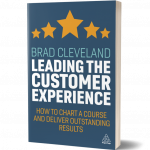The first step in leading customer experience is to understand what customer experience really is…and to ensure your team understands it in the same way.
Most customer experience definitions refer to “touchpoints”—customer experience is the sum of all of the touchpoints customers have with your organization. While I don’t disagree, I’ve found that 
So, I go a different route, simpler and with less explaining involved. I define customer experience as:
- everything a prospect or customer hears about your organization;
- every interaction they have with your organization and its products and services;
- and, ultimately, how they feel about your organization.
Let’s break this down a bit more, point by point.
Everything a prospect or customer hears about your organization. Some will come from your organization’s marketing department. But much will also come from your employees, other customers, or other stakeholders (critics, reviewers, and others).
Every interaction they have with your organization and its products and services. This includes pre- and post-sales interactions, the support theyreceive, the ease of understanding and using products and services, and theproducts themselves.
How they feel about your organization. Ultimately, customers develop an overall feeling about your organization. It may be a sense of calm, confidence, or excitement. It could be one of stress or dread. In many cases, it’s a combination.
Can you control everything a prospect hears about your organization? Of course not. But can you do such a good job that you create customer advocates who are inclined to say good things? Of course!
Can you control every interaction they have with you? Well, more so than some things—but stuff happens.
Can you set up systems, processes, and training that ensure the vast majority of interactions go well? Hire employees who care about the work they do and the impact it has on customers? Shape a culture that supports good decisions? Yes!
If customer experiences were simply a matter of mixing the right ingredients in the right way, effective leadership wouldn’t be in such high demand. You’ve got to understand customer experience in its fullest sense to make decisions that are right for your customers and your organization. And the answers for you will be different than for others.

Excerpt from Leading the Customer Experience: How to Chart a Course and Deliver Outstanding Results by Brad Cleveland.



0 Comments